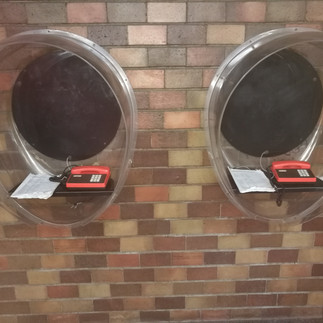SLOVAK RADIO BUILDING – UNIQUE ARCHITECTURAL AND TECHNICAL SIGHT IN BRATISLAVA
During a business trip and our participation in colloquium called Unplanned Planned Cities in Bratislava on 8 November 2017, we also visited the Slovak Radio Building which is shaped like an upside-down pyramid. The visit was thematically related to the focus of the colloquium. That is because the urban layout of the Slovak Radio building was a part of urban planning concept of the so-called Transverse Axis, a 90-meter-wide city boulevard passing from the Central Railway Station to the cultural and social centre. The concept has never been realized and only a few fragments, including the Slovak Radio building, were built.
The Slovak Radio building, one of Bratislava's architectural dominants, was built at the time of socialist realism dominance in the Eastern Bloc countries. Between the project and the construction of the building itself, long 22 years passed. The construction of the radio was preceded by two rounds of competitions in 1962 and 1963. The winner was an architect Miloš Chorvat, but after considering all advantages and disadvantages the investor decided to realize the third highest awarded design of architectural team Štefan Svetko – Štefan Ďurkovič – Barnabáš Kissling. The project of the building originated in 1967 and its construction was finished in 1983. The Slovak Radio is an exceptional building bearing the testimony of the era that was favourable towards generous solutions. So the creators could experiment, use progressive technologies and design principles.
Despite the fact that there are more buildings designed as an upside-down pyramids in the world (e.g. The City Hall of Tempe in Arizona, the Clancy Real Estate Group building in Phoenix, the Hanoi Museum or the Piere building in Florida) the Slovak Radio Building is unique architectural and technical heritage thanks to its original design for radio needs. In fact, it is not only one up-side-down pyramid, but two pyramids slid into each other. Because of noise-free space, the recording studios, concert halls, cutting rooms and all other rooms for working with sound are situated in the inner pyramid. The outer pyramid acts as a sound curtain protecting the purity of the sound for the need of the radio and at the same time is used for offices. But not just the construction of the whole building is unique, there is a concert hall studio with the volume of 12.000 m3 which is completely suspended and sprung in a whole-concrete body. In the concert hall is also one of the largest organs in Slovakia.
As soon as you enter the building, the spirit of the time will come to you and you find yourself returning at least 30 years back in time. This atmosphere is not only made by materials that you would hardly find today, but also by the equipment and furniture. Despite the fact that the building still serves the purpose of the radio, in many aspects, you feel more like in a museum. But there are many problems that are caused by the megalomanian project, changing the era and the needs of a modern radio. The building is energy-intensive. Not only because the old technologies and technical condition of the building, but also the capacity of the building is 1.500 employees but the capacity has never been filled (nowadays about 800 employees work in the building but not at the same time). Repairs are very expensive because materials used during construction, such as tiles, are no longer available on the market. And, of course, the demands on the space are still being diminished with the onset of digital technologies. Classifying the building as a National Cultural Heritage in the near future could help to finance the reconstruction and maintenance of the building but at the same time, it will make it more expensive and more difficult to solve problems related with repairing of the building.
There has been a long discussion in Slovakia about the future of the building. There are still voices for the sale and redevelopment of the building. But I hope there will be found a solution to preserve this unique architectural, technical and cultural sight and at the same time sustainable use for it. It would be a great shame to lose one of the architectural dominants of Bratislava, but for me, the Slovak Radio building also represents at least the European architectural and technical heritage.
Text and photo: Ondřej Jirásek










